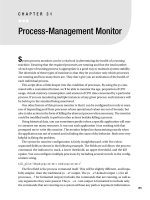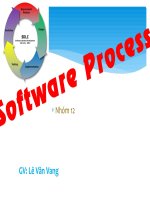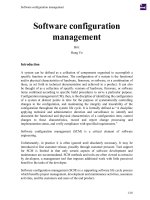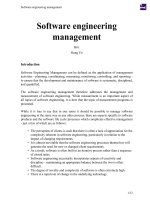Project teams software process management
Bạn đang xem bản rút gọn của tài liệu. Xem và tải ngay bản đầy đủ của tài liệu tại đây (731.93 KB, 57 trang )
International School
Software Measurements Reusability
CMU – CS 462 JIS
Software Process Management
Date: June 16 t , 2023
h
Submitted by
Nguyen Duc Thien
Le Hoang Vinh
N
g
u
Approved by y
e
Dr. ANAND NAYYAR
n
H
o
a
n
g
H
u
n
g
International School
Software Measurements Reusability
CMU – CS 462 JIS
Date: June 16 t , 2023
h
Submitted by
Nguyen Duc Thien
Le Hoang Vinh
N
g
u
Approved by y
e
TS. ANAND NAYYAR
n
H
o
a
n
g
H
u
n
g
Agenda
I. Introduction............................................................................................................................................3
1. Definition and significance of Software Process Management.......................................................3
a. Definition........................................................................................................................................3
b.Significance.....................................................................................................................................4
2. Importance of managing software development processes efficiently...........................................6
3. Overview of the challenges faced in software development............................................................8
II.Software Process Management topic details......................................................................................12
1. Key Concepts of Software Process Management..........................................................................12
a. Software development lifecycle and its phases..........................................................................12
b. The role of processes in software development.........................................................................12
c. Benefits of adopting SPM practices............................................................................................14
d. Common methodologies and frameworks used in SPM...........................................................15
2. Components of Software Process Management.............................................................................16
a. Process planning and documentation.........................................................................................16
b. Process implementation and enforcement.................................................................................18
c. Monitoring, control, and measurement......................................................................................20
d. Continuous process improvement and optimization.................................................................21
e. Risk management in software development...............................................................................23
3. Software Development Methodologies and SPM...........................................................................25
a. Traditional methodologies (e.g., Waterfall model)....................................................................25
b. Agile methodologies (e.g., Scrum, Kanban)...............................................................................26
4. Tools and Automation in SPM........................................................................................................27
a. Introduction to software process management tools.................................................................27
b. Automation and workflow management in SPM......................................................................29
c. Benefits of using tools to streamline software processes...........................................................30
III. Diagrams............................................................................................................................................32
IV. Steps, Concepts, Framework and Example:...................................................................................37
1.Steps for Software Process Management:.......................................................................................37
2.Concepts in Software Process Management:..................................................................................38
3.Frameworks for Software Process Management:..........................................................................38
4.Example:...........................................................................................................................................38
V.Latest Information coverage to Topic:...............................................................................................39
1.Software process management metrics...........................................................................................39
2.Current issues in software process management: A critical review of legal & methodological
issues.....................................................................................................................................................44
3.The power of software process management..................................................................................45
VI. Case Study based Discussion:...........................................................................................................47
1.Case Study.........................................................................................................................................47
2.Benefits and Results..........................................................................................................................51
VII.Conclusions..........................................................................................................................................53
References................................................................................................................................................54
I. Introduction
1. Definition and significance of Software Process Management
a. Definition.
Software Process Management (SPM) is a discipline that encompasses a broad range of
practices, methodologies, and techniques aimed at effectively managing software
development processes within organizations. It focuses on planning, implementing,
monitoring, and controlling these processes to ensure efficient and high-quality software
delivery.
At its core, SPM recognizes that software development is a complex and multifaceted
activity that requires well-defined and controlled processes to achieve successful outcomes. It
involves systematically organizing and coordinating the activities involved in software
development, from the initial requirements gathering to the final deployment and
maintenance of software systems.
The primary objective of SPM is to improve the efficiency, effectiveness, and quality of
software development projects. By establishing standardized processes, organizations can
ensure that development teams follow consistent procedures and workflows. This
consistency leads to better resource allocation, reduced rework, and improved overall
productivity.
SPM emphasizes the importance of process planning as a critical initial step. This involves
analyzing project requirements, defining the necessary activities, identifying the roles and
responsibilities of team members, and allocating resources accordingly. Process planning
also includes setting project milestones, estimating timeframes, and establishing project
management strategies.
Once the processes are planned, the next phase of SPM is process implementation. This stage
involves training the development team on the adopted processes, providing them with the
necessary tools and resources, and ensuring their understanding and compliance. Process
implementation also includes setting up communication channels, establishing collaboration
platforms, and integrating supportive technologies.
Monitoring and control are essential aspects of SPM, allowing organizations to track and
evaluate the progress of software development projects. This involves establishing key
performance indicators (KPIs) and metrics to measure the effectiveness of the processes.
Regular assessments are conducted to identify bottlenecks, deviations, and areas for
improvement. Monitoring and control enable organizations to take corrective actions and
ensure that projects stay on track and within defined parameters.
Continuous process improvement is a key principle of SPM. It involves analyzing process
data, identifying inefficiencies, and implementing changes to optimize the software
development lifecycle. Techniques such as root cause analysis, statistical process control, and
lean principles are often used to drive process improvement initiatives. Continuous
improvement helps organizations refine their processes, increase productivity, and adapt to
changing business and market needs.
Risk management is another critical aspect of SPM. It involves identifying and mitigating
potential risks and uncertainties associated with software development projects. Risk
assessment techniques, such as conducting risk workshops, maintaining risk registers, and
employing risk management frameworks, help organizations proactively address and
minimize the impact of potential failures or disruptions.
Documentation and knowledge management are integral to SPM. Well-documented
processes, procedures, and guidelines ensure that knowledge is captured, shared, and retained
within the organization. This documentation serves as a reference for future projects, aids in
onboarding new team members, and promotes consistency in software development
practices.
Various methodologies and frameworks are employed in SPM, each offering a different
approach to software development. Traditional methodologies, such as the Waterfall model,
follow a sequential and phased approach. Agile methodologies, including Scrum and
Kanban, promote iterative and collaborative development, allowing for flexibility and
responsiveness to changing requirements. Lean software development focuses on eliminating
waste and maximizing customer value. DevOps integrates development and operations,
emphasizing continuous integration, delivery, and feedback.
SPM also aligns with industry standards and best practices. International standards like
ISO/IEC 12207 (Software Development Life Cycle Processes) and ISO/IEC 15504
(Capability Maturity Model Integration - CMMI) provide frameworks for assessing and
improving software development processes. Adhering to these standards helps organizations
maintain quality, enhance their reputation, and improve customer satisfaction.
In recent years, the advent of technology has played a significant role in SPM. Software
process management tools and platforms have emerged, offering features such as process
modeling, workflow automation, task tracking
b.Significance.
The significance of Software Process Management (SPM) lies in its ability to bring about
numerous benefits and improvements to the software development process. By implementing
effective SPM practices, organizations can enhance their overall performance, increase
efficiency, reduce risks, and deliver higher-quality software products. Here are some key
aspects that highlight the significance of SPM:
- Consistency and Standardization: SPM promotes consistency and standardization in
software development processes. By establishing standardized procedures, organizations
ensure that all teams follow the same best practices, resulting in greater predictability and
reduced variability in project outcomes. Consistency enables better resource allocation,
improved collaboration, and easier transfer of knowledge between team members.
- Improved Productivity: SPM aims to streamline processes and eliminate inefficiencies. By
identifying and addressing process bottlenecks, organizations can optimize resource
utilization and reduce time wasted on non-value-added activities. With efficient processes in
place, teams can focus on delivering high-quality software within shorter timeframes,
resulting in increased productivity.
- Quality Enhancement: SPM places a strong emphasis on quality throughout the software
development lifecycle. By incorporating quality assurance practices, rigorous testing, and
adherence to industry standards, organizations can identify and address defects and issues at
early stages, reducing the likelihood of costly rework and customer dissatisfaction. Improved
quality leads to higher customer satisfaction, increased trust, and a competitive advantage in
the market.
- Risk Mitigation: SPM includes risk management as a fundamental component. By
proactively identifying and assessing risks associated with software development projects,
organizations can develop appropriate mitigation strategies. This helps in minimizing
potential disruptions, delays, and budget overruns. Effective risk management ensures that
projects stay on track and that potential issues are addressed in a timely manner.
- Continuous Improvement: SPM promotes a culture of continuous improvement. By
regularly monitoring and measuring key performance indicators (KPIs), organizations can
identify areas for enhancement and implement process refinements. Continuous process
improvement enables teams to adapt to changing requirements, leverage emerging
technologies, and incorporate lessons learned from previous projects. This iterative approach
fosters innovation and ensures that processes evolve with the dynamic nature of the software
industry.
- Collaboration and Communication: SPM emphasizes effective collaboration and
communication among team members. By providing a structured framework and defined
roles, SPM facilitates clear communication channels and encourages collaboration across
different functional areas. This leads to improved coordination, better problem-solving, and
enhanced team synergy, resulting in smoother project execution and reduced conflicts.
- Compliance and Governance: SPM helps organizations adhere to industry standards,
regulatory requirements, and best practices. Compliance with standards such as ISO/IEC
12207 and ISO/IEC 15504 ensures that software development processes meet international
benchmarks and quality criteria. This not only enhances the organization's credibility but also
enables smoother audits and certifications.
- Knowledge Management: SPM emphasizes documentation and knowledge sharing. By
documenting processes, best practices, and lessons learned, organizations can capture and
retain valuable knowledge within the organization. This knowledge repository serves as a
reference for future projects, aids in training new team members, and promotes knowledge
sharing and collaboration across teams.
- Adaptability and Flexibility: SPM allows organizations to adapt to changing market
demands and technological advancements. By implementing agile methodologies or adopting
DevOps practices, organizations can respond quickly to evolving customer needs and deliver
software in a more iterative and incremental manner. SPM enables flexibility, enabling
organizations to embrace new approaches and technologies to stay competitive in the rapidly
evolving software landscape.
In summary, Software Process Management is significant as it enables organizations to
establish efficient and standardized processes, improve productivity and quality, mitigate
risks, foster collaboration, and continuously enhance their software development practices.
By implementing SPM, organizations can achieve better project outcomes, increased
customer satisfaction, and a competitive edge in the dynamic software industry.
2. Importance of managing software development processes efficiently.
Managing software development processes efficiently is of paramount importance for
organizations operating in the software industry. Efficient management of these processes
brings numerous benefits and positively impacts various aspects of software development.
Here are the key reasons highlighting the importance of managing software development
processes efficiently:
Time and Cost Savings:
Efficient process management eliminates bottlenecks and reduces delays, resulting in
shorter project timelines. This allows organizations to bring software products to
market faster, gaining a competitive advantage.
By optimizing resource allocation and minimizing waste, organizations can reduce
unnecessary expenses and lower overall project costs.
Efficient processes also enable accurate project estimation, ensuring that resources
and budgets are effectively allocated.
Improved Productivity:
Efficient process management enables teams to work more productively by
eliminating unnecessary steps and reducing administrative overhead.
By providing clear guidelines and standardized procedures, efficient processes
eliminate confusion and enable team members to focus on their core tasks.
Automated tools and streamlined workflows reduce manual effort, allowing teams to
work more efficiently and accomplish more in less time.
Enhanced Quality:
Efficient process management incorporates quality assurance practices throughout the
development lifecycle, including comprehensive testing, code reviews, and adherence
to coding standards.
By establishing quality control measures, organizations can identify and rectify
defects early, preventing them from propagating to later stages and improving overall
product quality.
Efficient processes promote continuous quality monitoring and improvement,
ensuring that customer requirements and industry standards are met consistently.
Risk Mitigation:
Efficient process management includes robust risk identification and mitigation
strategies. By proactively addressing risks, organizations can minimize their impact
on project schedules, budgets, and quality.
Effective risk management ensures that potential issues are identified early, allowing
for timely resolution and preventing costly setbacks.
Regular risk assessments and mitigation actions increase project predictability,
reducing the likelihood of unexpected challenges derailing the software development
process.
Improved Collaboration and Communication:
Efficient process management establishes clear communication channels and
facilitates collaboration among team members, stakeholders, and customers.
Defined roles, responsibilities, and workflows enable effective coordination, ensuring
that everyone is aligned towards common goals.
Efficient processes promote transparency, enabling better communication of project
status, issues, and progress to all stakeholders, fostering trust and reducing
misunderstandings.
Scalability and Growth:
Efficient process management allows organizations to scale their software
development operations smoothly without sacrificing quality or increasing risks.
Well-documented processes provide a foundation for knowledge transfer and
onboarding new team members, facilitating growth and team expansion.
Scalable processes enable organizations to handle increased project complexity,
volume, and diversity while maintaining consistency and efficiency.
Customer Satisfaction:
Efficient process management focuses on meeting customer requirements and
expectations, leading to higher customer satisfaction levels.
By delivering software projects on time and with high quality, organizations build
trust and credibility with their customers.
Efficient processes ensure that software products meet the desired functionality,
usability, and performance, resulting in customer delight and loyalty.
Continuous Improvement:
Efficient process management fosters a culture of continuous improvement,
encouraging teams to identify areas for enhancement and implement iterative
changes.
Regular process evaluations and data-driven analysis help identify bottlenecks,
inefficiencies, and areas of improvement, leading to ongoing optimization.
Continuous improvement drives innovation, promotes learning, and ensures that
processes remain adaptable to evolving technologies and market trends.
Compliance and Auditability:
Efficient process management enables organizations to comply with industry
standards, regulatory requirements, and internal policies.
Well-documented processes and adherence to quality control measures ensure that
organizations meet auditing and compliance criteria.
Compliance with standards enhances the organization's reputation, increases customer
trust, and opens doors to new business opportunities.
Adaptability to Change:
Efficient process management enables organizations to respond quickly to market
changes, customer feedback, and emerging technologies.
Agile methodologies, such as Scrum or Kanban, promote flexibility and adaptability,
allowing teams to embrace evolving requirements and deliver value incrementally.
Efficient processes incorporate feedback loops, enabling organizations to make timely
adjustments and course corrections, resulting in improved customer satisfaction and
business outcomes.
In conclusion, managing software development processes efficiently is crucial for
organizations seeking to achieve successful software projects. It leads to time and cost
savings, improved productivity and quality, risk mitigation, enhanced collaboration,
scalability, customer satisfaction, continuous improvement, compliance, and adaptability.
Efficient process management sets the foundation for successful software development
and helps organizations stay competitive in the rapidly evolving software industry.
By focusing on efficient process management, organizations can optimize their software
development efforts, reduce risks, improve collaboration, enhance customer satisfaction,
and create a foundation for continuous improvement and growth.
3. Overview of the challenges faced in software development.
Software development is a complex and dynamic process that often presents numerous
challenges to organizations and development teams. These challenges can arise from various
factors, including project requirements, technology constraints, team dynamics, and market
pressures. Here is an extensive overview of the challenges faced in software development:
Changing Requirements: Requirements often evolve throughout the software
development lifecycle, posing a significant challenge. As stakeholders and users gain
a better understanding of their needs, new requirements may emerge or existing ones
may change. Managing changing requirements requires effective communication,
flexible processes, and the ability to adapt to evolving needs.
Project Management: Effective project management is crucial for successful software
development. Challenges in this area include defining project scope, setting realistic
timelines, allocating resources effectively, managing dependencies, and ensuring that
project goals are met within budgetary constraints.
Technology Selection and Integration: Choosing the right technologies and ensuring
their seamless integration can be challenging. With a wide range of programming
languages, frameworks, libraries, and tools available, making informed decisions
requires expertise and a thorough understanding of project requirements, scalability,
security, and future maintainability.
Technical Complexity: Software development often involves addressing complex
technical challenges. Developing intricate algorithms, handling large data sets,
ensuring system scalability and performance, and integrating disparate systems can
present significant difficulties. Overcoming technical complexities requires skilled
developers and architects with in-depth domain knowledge.
Quality Assurance and Testing: Ensuring the quality of software products is a
continuous challenge. Rigorous testing, including unit testing, integration testing, and
user acceptance testing, is essential to identify and rectify defects. Time and resource
constraints, maintaining test coverage, and verifying software functionality across
different platforms and configurations are common challenges in this area.
Communication and Collaboration: Effective communication and collaboration are
vital for successful software development. Challenges arise when team members are
geographically dispersed, work in different time zones, or have language and cultural
barriers. Miscommunication, lack of clarity, and coordination issues can hinder
progress and impact project outcomes.
Project Scope Management: Managing project scope can be challenging, especially
when stakeholders request additional features or changes that fall outside the initial
project scope. Scope creep can lead to timeline delays, increased costs, and resource
allocation issues. Balancing stakeholder expectations and maintaining scope
boundaries is critical for project success.
Team Dynamics and Skill Gaps: Software development requires collaboration among
diverse team members with different skill sets and backgrounds. Challenges can arise
from conflicting personalities, poor team dynamics, skill gaps, or turnover of team
members. Building a cohesive team, fostering effective communication, and
addressing skill gaps through training and knowledge sharing are crucial for success.
Resource Allocation and Management: Allocating and managing resources efficiently
is a common challenge in software development. Balancing the workload across team
members, identifying and resolving resource constraints, and optimizing resource
utilization to meet project deadlines require effective resource management practices.
Security and Privacy: Developing secure and privacy-compliant software is a
significant challenge, especially in an increasingly interconnected world. Ensuring
data protection, implementing robust authentication and authorization mechanisms,
and addressing vulnerabilities and cyber threats require constant vigilance and
adherence to industry best practices.
Time and Cost Constraints: Meeting project deadlines and budget constraints is a
perpetual challenge in software development. Estimating project effort accurately,
managing risks, and balancing competing priorities are crucial to delivering software
within defined timeframes and budgets.
Adoption of New Technologies: Incorporating new technologies and frameworks into
software development processes can be challenging. Learning curves, compatibility
issues, and limited documentation may hinder the seamless adoption of emerging
technologies. Organizations must invest in training and provide time for developers to
familiarize themselves with new tools and techniques.
Stakeholder Management: Effectively managing stakeholders' expectations and
requirements is crucial for project success. Addressing conflicting stakeholder
priorities, managing multiple stakeholders with different interests
User Experience Design: Designing software that provides a seamless and intuitive
user experience is a challenge. Understanding user needs, incorporating feedback, and
creating user-friendly interfaces require a combination of design expertise and
usability testing.
Scalability and Performance: Building software that can handle increasing user loads
and data volumes while maintaining performance is a challenge. Anticipating
scalability requirements, optimizing code efficiency, and implementing proper
caching and database design are essential for scalable and high-performing
applications.
Legacy System Integration: Integrating new software with existing legacy systems
can be challenging due to compatibility issues, data migration complexities, and
differing architectural principles. Ensuring seamless integration, data integrity, and
interoperability require careful planning and implementation.
Intellectual Property Protection: Protecting intellectual property rights, including
code, algorithms, and proprietary technologies, is a challenge in software
development. Implementing proper security measures, adhering to licensing
agreements, and safeguarding against unauthorized access or infringement require
robust legal and technological frameworks.
Compliance with Regulations: Developing software that complies with industry
regulations and legal requirements, such as data privacy (e.g., GDPR) and
accessibility standards, presents challenges. Understanding and implementing
complex regulatory frameworks, ensuring data protection, and accommodating
diverse user needs can be demanding.
Software Maintenance and Upgrades: Maintaining and upgrading software over its
lifecycle is a significant challenge. Bug fixes, performance enhancements, feature
updates, and security patches need to be managed efficiently while minimizing
disruption to end-users. Ensuring backward compatibility and providing adequate
support require careful planning and release management.
Software Documentation: Creating comprehensive and up-to-date documentation is
often a challenge. Documenting software design, architecture, APIs, user manuals,
and release notes require dedicated effort and can be overlooked amidst project
deadlines. Well-documented software facilitates future maintenance, troubleshooting,
and knowledge transfer.
Cultural and Organizational Challenges: Software development teams may face
cultural and organizational challenges that impact productivity and collaboration.
Differences in work styles, communication norms, and organizational hierarchies can
hinder effective teamwork. Promoting a positive work culture, fostering diversity and
inclusion, and encouraging open communication are important for overcoming such
challenges.
Project Dependencies: Software development projects often have dependencies on
external factors, such as third-party APIs, hardware components, or service providers.
Managing these dependencies, ensuring their availability and compatibility, and
addressing issues that arise from external dependencies can be challenging.
Agile Transformation: Adopting agile methodologies, such as Scrum or Kanban, can
present challenges for organizations transitioning from traditional waterfall
approaches. Changing mindsets, adjusting organizational structures, and establishing
effective agile practices require a cultural shift and ongoing commitment to agile
principles.
Data Management and Big Data: Handling and processing large volumes of data, as
well as ensuring data accuracy, privacy, and security, is a challenge in software
development. Developing efficient data management strategies, implementing proper
data governance, and leveraging appropriate technologies for big data analytics are
critical.
Market Competition and Innovation: The software industry is highly competitive, and
staying ahead requires continuous innovation. Keeping pace with emerging
technologies, monitoring market trends, and delivering innovative solutions that meet
evolving customer needs are ongoing challenges.
Project Communication and Documentation: Effective communication and
documentation throughout the software development lifecycle are vital for successful
project execution. Ensuring clear and consistent communication between team
members, stakeholders, and clients, as well as maintaining accurate and updated
documentation, can be challenging in distributed teams or fast-paced environments.
Technical Debt: Technical debt refers to the accumulated cost of rework or
refactoring required due to suboptimal design or coding decisions made during
development. Managing technical debt and balancing the need for rapid development
with long-term maintainability can be a challenge, as neglecting technical debt can
impact.
II.Software Process Management topic details
1. Key Concepts of Software Process Management
a. Software development lifecycle and its phases.
The software development lifecycle (SDLC) is a systematic process that outlines the stages
involved in developing software. It provides a structured approach for organizations to plan,
design, build, test, deploy, and maintain software systems. While specific methodologies and
frameworks may vary, the SDLC typically consists of the following phases:
Requirements Gathering: In this phase, project stakeholders, including clients, users,
and development teams, identify and document the software requirements. This
involves understanding the problem domain, gathering user needs, and defining the
functional and non-functional requirements of the software.
Analysis and Design: The analysis and design phase focuses on translating the
requirements into a technical solution. It involves analyzing the gathered
requirements, identifying system components, defining the software architecture, and
designing the data structures, interfaces, and algorithms.
Implementation: The implementation phase involves writing code and developing the
software solution based on the defined design. Developers utilize programming
languages, frameworks, and tools to build the software components. This phase
includes coding, unit testing, and integrating the different modules or components.
Testing: The testing phase is crucial for ensuring the quality and reliability of the
software. Various testing techniques, such as unit testing, integration testing, system
testing, and acceptance testing, are employed to identify defects, validate
functionality, and verify that the software meets the specified requirements.
Deployment: Once the software has passed the testing phase, it is ready for
deployment. This involves preparing the software for production environments,
configuring servers, installing the necessary infrastructure, and ensuring proper
integration with existing systems. Deployment also includes data migration and
training end-users on how to use the software effectively.
Maintenance: The maintenance phase involves managing and enhancing the software
after its deployment. It includes bug fixes, software updates, performance
optimization, and addressing user feedback. Maintenance can also involve adding
new features, improving scalability, and ensuring the software remains secure and
compatible with evolving technologies.
Throughout the SDLC, organizations may adopt various methodologies or frameworks, such
as Waterfall, Agile (e.g., Scrum or Kanban), or DevOps, to structure their development
processes and adapt to project-specific needs. Each phase in the SDLC plays a critical role in
ensuring the successful delivery of high-quality software systems.
b. The role of processes in software development.
Processes play a vital role in software development by providing structure, consistency, and
guidance to the development teams. Here are some key roles of processes in software
development:
Standardization: Processes establish a set of standardized practices and procedures
that ensure consistency in software development activities. By defining a common
framework for carrying out tasks, processes help teams work together seamlessly,
regardless of individual differences or preferences. Standardization promotes
efficiency, reduces errors, and improves overall productivity.
Risk Management: Processes help identify, assess, and mitigate risks associated with
software development projects. They provide guidelines for risk analysis, risk
mitigation strategies, and risk monitoring throughout the development lifecycle. By
proactively addressing potential risks, processes enable teams to make informed
decisions and take necessary actions to minimize project disruptions and ensure
project success.
Quality Assurance: Processes facilitate quality assurance activities by defining
quality standards, best practices, and quality control mechanisms. They guide teams
in conducting code reviews, performing testing activities, and ensuring compliance
with coding guidelines and industry standards. By incorporating quality checkpoints
at various stages, processes help identify and rectify defects early in the development
process, resulting in higher-quality software.
Collaboration and Communication: Processes promote effective collaboration and
communication among team members, stakeholders, and clients. They establish
channels for sharing information, coordinating tasks, and resolving conflicts. By
defining roles, responsibilities, and communication protocols, processes facilitate
transparent and efficient communication, reducing misunderstandings and enhancing
teamwork.
Project Planning and Management: Processes provide a structured approach to
project planning and management. They help define project goals, scope,
deliverables, and timelines. Processes guide teams in estimating effort, allocating
resources, and tracking progress. They also establish mechanisms for project
monitoring, reporting, and change management, ensuring projects are executed
according to plan and within defined constraints.
Documentation and Knowledge Management: Processes emphasize the importance of
documentation and knowledge management throughout the software development
lifecycle. They define requirements documentation, design documents, test plans, and
user manuals, ensuring that important project information is captured and shared. By
documenting processes and lessons learned, organizations can leverage knowledge
for future projects, improve efficiency, and enable smooth knowledge transfer within
teams.
Continuous Improvement: Processes encourage a culture of continuous improvement
by providing a framework for evaluating and refining development practices. They
enable teams to analyze project outcomes, identify areas for improvement, and
implement process enhancements. By fostering a mindset of learning and adaptation,
processes drive innovation, efficiency, and effectiveness in software development.
Compliance and Governance: Processes ensure compliance with regulatory
requirements, industry standards, and organizational policies. They guide teams in
adhering to data privacy regulations, security guidelines, and other legal and ethical
considerations. Processes also support governance by establishing controls, audits,
and review mechanisms to monitor adherence to defined processes and policies.
Overall, processes in software development provide a structured approach, promote
collaboration, ensure quality, facilitate risk management, enable effective communication,
and drive continuous improvement. They serve as a foundation for successful software
delivery by guiding teams through the complex and iterative nature of software development
projects.
c. Benefits of adopting SPM practices.
Adopting Software Project Management (SPM) practices can offer numerous benefits for
organizations. Here are some key advantages:
Improved Project Success: SPM practices provide a structured approach to project
management, enabling better planning, execution, and control. This increases the likelihood
of project success by delivering projects on time, within budget, and meeting quality
expectations.
Enhanced Productivity: SPM practices emphasize effective resource allocation, task
prioritization, and scheduling. By adopting these practices, organizations can optimize their
resources, reduce wastage, and improve team productivity.
Better Risk Management: SPM practices facilitate systematic identification, analysis, and
mitigation of project risks. By proactively addressing risks, organizations can minimize the
impact of potential issues and avoid costly delays or failures.
Clearer Communication and Collaboration: SPM practices promote clear communication
channels, stakeholder engagement, and collaboration among project teams. This helps ensure
that everyone involved has a shared understanding of project goals, tasks, and timelines,
leading to improved teamwork and reduced misunderstandings.
Efficient Change Management: SPM practices enable organizations to handle changes
effectively. By establishing change control processes, organizations can evaluate the impact
of requested changes, assess their feasibility, and manage them systematically, thereby
minimizing disruptions and ensuring project stability.
Enhanced Quality Assurance: SPM practices advocate for quality management throughout
the project lifecycle. By implementing quality assurance processes, organizations can
identify defects early, apply appropriate testing methodologies, and ensure that the final
product meets or exceeds customer expectations.
Increased Customer Satisfaction: Through effective project planning and execution, SPM
practices enable organizations to deliver projects that align with customer requirements. This
leads to higher customer satisfaction, improved reputation, and increased customer loyalty.
Continuous Improvement: SPM practices emphasize monitoring, evaluation, and learning
from project experiences. By conducting post-project reviews and capturing lessons learned,
organizations can identify areas for improvement and refine their project management
processes over time.
Scalability and Adaptability: SPM practices provide a scalable framework that can be
tailored to suit projects of varying sizes and complexities. This adaptability allows
organizations to apply consistent project management practices across different projects,
ensuring a standardized approach and facilitating knowledge transfer.
Cost Control: By employing SPM practices, organizations can establish better cost control
mechanisms. These practices enable effective budgeting, resource allocation, and monitoring
of project expenses, helping organizations optimize costs and prevent budget overruns.
Overall, adopting SPM practices can lead to improved project outcomes, increased
organizational efficiency, and a competitive advantage in the dynamic and demanding field
of software development.
d. Common methodologies and frameworks used in SPM.
There are several commonly used methodologies and frameworks in Software Project
Management (SPM). Here are some of the most popular ones:
1. Waterfall Model: The Waterfall model is a sequential approach where projects
progress through distinct phases such as requirements gathering, design,
implementation, testing, and deployment. Each phase must be completed before
moving on to the next. It is a traditional and highly structured methodology suitable
for projects with well-defined requirements and stable environments.
2. Agile Methodology: Agile methodologies, including Scrum, Kanban, and Extreme
Programming (XP), are iterative and incremental approaches to project management.
They prioritize adaptability, collaboration, and frequent delivery of working software.
Agile methods emphasize flexibility, customer collaboration, and responding to
change throughout the project lifecycle.
3. Scrum Framework: Scrum is an Agile framework that focuses on iterative
development and cross-functional teamwork. It divides the project into short
iterations called sprints, typically lasting two to four weeks. Scrum involves selforganizing teams, daily stand-up meetings, sprint planning, sprint reviews, and
retrospectives to continuously refine and improve the project.
4. Kanban Method: Kanban is an Agile framework that visualizes project workflow on a
Kanban board, allowing teams to track and manage work in progress (WIP). It
emphasizes limiting WIP, promoting a smooth flow of work, and optimizing team
efficiency. Kanban provides transparency and flexibility in managing tasks, allowing
teams to respond quickly to changes.
5. Lean Software Development: Lean Software Development is a methodology inspired
by lean manufacturing principles. It focuses on eliminating waste, maximizing
customer value, and continuous improvement. It emphasizes concepts such as value
stream mapping, reducing defects, just-in-time delivery, and empowering the
development team.
6. PRINCE2 (Projects IN Controlled Environments): PRINCE2 is a widely used project
management framework that provides a structured and process-driven approach. It
offers a set of best practices and principles, including well-defined roles and
responsibilities, project stages, management by exception, and regular project
reviews. PRINCE2 is often used in large-scale projects with a focus on project
governance and control.
7. PMBOK (Project Management Body of Knowledge): PMBOK is a comprehensive
guide and framework published by the Project Management Institute (PMI). It
outlines standard practices, processes, and knowledge areas in project management.
PMBOK encompasses project initiation, planning, execution, monitoring and control,
and project closure. It serves as a foundation for project management and is
commonly used for certification purposes.
8. DevOps: DevOps is a cultural and operational framework that promotes collaboration
between development (Dev) and operations (Ops) teams. It aims to improve the
speed, quality, and efficiency of software delivery by integrating development,
testing, and operations processes. DevOps emphasizes automation, continuous
integration, continuous delivery, and close collaboration between teams.
9. Six Sigma: Six Sigma is a data-driven methodology focused on improving process
efficiency and reducing defects. While initially developed for manufacturing, it has
been applied to software development as well. Six Sigma employs statistical tools and
techniques to measure and analyze processes, identify areas of improvement, and
implement solutions to achieve higher quality and customer satisfaction.
10. Rational Unified Process (RUP): RUP is an iterative software development
framework that provides guidelines for project management, software development,
and process customization. It emphasizes iterative development, risk management,
and architecture-centric approaches. RUP consists of phases, workflows, and artifacts
that guide project teams throughout the software development lifecycle.
These methodologies and frameworks offer different approaches to project management,
allowing organizations to choose the most suitable one based on project characteristics, team
dynamics, and organizational needs.
2. Components of Software Process Management
a. Process planning and documentation
Software Process Management (SPM) involves planning and managing the processes used in
software development projects. Process planning and documentation play crucial roles in
ensuring that software projects are executed efficiently and consistently. Here's a closer look
at process planning and documentation in SPM:
Process Planning:
Define Project Objectives: Clearly define the objectives, goals, and scope of the software
project. This helps in determining the required processes and activities to achieve those
objectives.
Identify Process Requirements: Identify the specific processes and activities that need to be
performed to deliver the software project successfully. This includes determining the
development methodology, such as Agile, Waterfall, or a hybrid approach.
Select Appropriate Processes: Select the most suitable processes that align with the project
requirements, development methodology, and organizational context. This may involve using
industry-standard processes or tailoring existing processes to meet project-specific needs.
Define Process Activities: Break down the selected processes into actionable activities. Each
activity should have clear inputs, outputs, responsibilities, and criteria for completion.
Establish Process Flow: Determine the sequence and dependencies of process activities.
Define how the activities are interrelated and the flow of information and deliverables
between them.
Allocate Resources: Determine the necessary resources, such as personnel, tools, and
infrastructure, needed to execute the planned processes effectively.
Set Timelines: Establish realistic timelines and milestones for completing process activities.
Consider dependencies, constraints, and the overall project schedule.
Identify and Mitigate Risks: Identify potential risks that may impact the planned processes
and develop strategies to mitigate them. This involves assessing risks, implementing risk
management techniques, and monitoring risks throughout the project.
Define Quality Assurance Measures: Establish quality assurance activities and criteria to
ensure that the processes and deliverables meet the desired quality standards. This includes
defining quality checkpoints, conducting reviews, and implementing testing and verification
activities.
Documentation:
Process Documentation: Document the planned processes, including process descriptions,
activity breakdowns, inputs, outputs, and responsibilities. This serves as a reference for the
project team, stakeholders, and future project management activities.
Project Plan: Develop a comprehensive project plan that includes the process plan, project
schedule, resource allocation, and risk management strategies. The project plan provides a
roadmap for executing the project and guides the project team throughout the development
lifecycle.
Requirements Documentation: Document the project requirements, including functional and
non-functional requirements. This ensures that the project team and stakeholders have a clear
understanding of what needs to be delivered.
Design and Technical Documentation: Document the design decisions, architecture, and
technical specifications of the software project. This documentation aids in communication,
knowledge sharing, and future maintenance and enhancements.
Test Plans and Documentation: Develop test plans and related documentation to ensure that
the software is thoroughly tested for functionality, performance, and reliability. This includes
test cases, test scripts, and test results.
Change Control Documentation: Document any changes to the planned processes,
requirements, or project scope. This includes change requests, change impact assessments,
and change approval records.
Lessons Learned Documentation: Capture and document lessons learned throughout the
project. This includes successes, challenges, and best practices identified during the project's
execution. These lessons learned can be used to improve future projects and enhance
organizational knowledge.
Effective process planning and documentation facilitate consistency, communication, and
collaboration within the project team and stakeholders. They provide a reference point for
project activities, enable effective monitoring and control, and contribute to the overall
success of software development projects.
b. Process implementation and enforcement.
Process implementation and enforcement are crucial aspects of Software Project
Management (SPM) that ensure the planned processes are effectively executed and adhered
to throughout the project. Here's an overview of process implementation and enforcement in
SPM:
Process Implementation:
Communicate Process Guidelines: Clearly communicate the planned processes, their
objectives, and the expected outcomes to the project team and stakeholders. Ensure that
everyone involved understands the processes and their role in executing them.
Training and Skill Development: Provide necessary training and support to the project team
to ensure they have the skills and knowledge required to implement the processes effectively.
This may include training on specific tools, techniques, or methodologies.
Allocate Roles and Responsibilities: Clearly define and communicate the roles and
responsibilities of team members regarding process implementation. Each team member
should understand their specific responsibilities and how they contribute to the overall
process execution.
Provide Process Documentation: Make process documentation readily available to the project
team and stakeholders. This documentation should include process descriptions, activity
guidelines, templates, and any other necessary resources to support process implementation.









